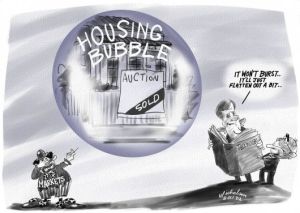Swedish housing bubble soon to burst High and rising household indebtedness poses the greatest risk to the Swedish economy. Household indebtedness has been increasing in Sweden since the mid- 1990s. Home ownership financed by high levels of mortgage debt with variable interest rates makes households vulnerable to falling house prices and increasing interest rates … In the present Economic Commentary, we extend the earlier analysis by using updated data covering the period up to September 2017 … Our main findings can be summarised as follows: 1. Household debt continues to increase faster than income. The average DTI ratio increased from 326 per cent in September 2016 to 338 per cent in September 2017. 2. More households have high debts relative to their
Topics:
Lars Pålsson Syll considers the following as important: Economics
This could be interesting, too:
Lars Pålsson Syll writes Schuldenbremse bye bye
Lars Pålsson Syll writes What’s wrong with economics — a primer
Lars Pålsson Syll writes Krigskeynesianismens återkomst
Lars Pålsson Syll writes Finding Eigenvalues and Eigenvectors (student stuff)
Swedish housing bubble soon to burst
High and rising household indebtedness poses the greatest risk to the Swedish economy. Household indebtedness has been increasing in Sweden since the mid- 1990s. Home ownership financed by high levels of mortgage debt with variable interest rates makes households vulnerable to falling house prices and increasing interest rates …
In the present Economic Commentary, we extend the earlier analysis by using updated data covering the period up to September 2017 … Our main findings can be summarised as follows:
1. Household debt continues to increase faster than income. The average DTI ratio increased from 326 per cent in September 2016 to 338 per cent in September 2017.
2. More households have high debts relative to their income. In 2017, 260 000 households had a DTI ratio exceeding 600 per cent. This is an increase of 27 000 households compared to 2016.
3. Household indebtedness is increasing for all income groups and age groups.
House prices are increasing fast in EU. And more so in Sweden than in any other member state. Sweden’s house price boom started in mid-1990s, and looking at the development of real house prices during the last three decades there are reasons to be deeply worried. As even The Riksbank now admits, the indebtedness of the Swedish household sector has risen to alarmingly high levels.
Yours truly has been trying to argue with ‘very serious people’ that it’s really high time to ‘take away the punch bowl.’ Mostly I have felt like the voice of one calling in the desert.

The Swedish housing market is living on borrowed time. It’s really high time to take away the punch bowl. What is especially worrying is that although the aggregate net asset position of the Swedish households is still on the solid side, an increasing proportion of those assets is illiquid. When the inevitable drop in house prices hits the banking sector and the rest of the economy, the consequences will be enormous.
It hurts when bubbles burst …
